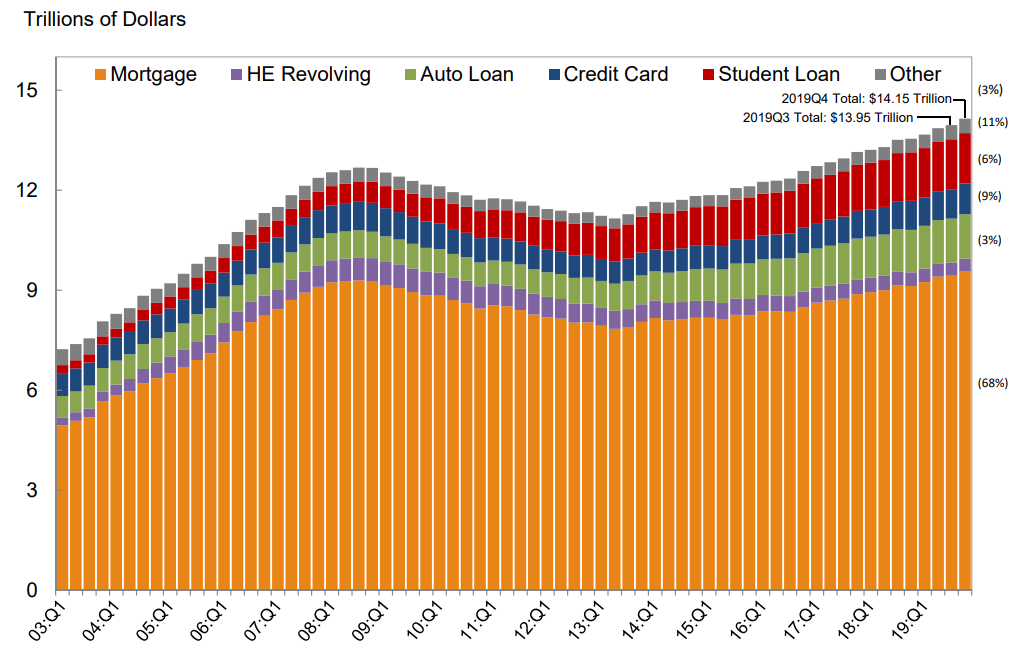A Snapshot of Record-High U.S. Household Debt

U.S. household debt had reached a record high in the fourth quarter of 2019, at $14.15 trillion, according to the New York Fed’s Quarterly Report on Household Debt and Credit. See the New York Fed’s Quarterly Report on Household Debt and Credit, a nationally representative sample of individual and household-level debt and credit records drawn from anonymized Equifax credit data. That was about $1.5 trillion more in nominal terms (that is, not inflation-adjusted) than household debt totals that previously peaked in 2008.
What made up the increase in household debt—and what could it mean for Americans? In this post we’ll take a closer look at household debt, including how it changed since the Great Recession.For a recap of the recession’s impact on consumers and the Fed’s response, see “The Great Recession” essay from Federal Reserve History.
As we move further away from that recession, many people under the age of 30 were in high school or college; they experienced the Great Recession through a different lens. They may have seen the stress the recession had on a parent, but likely weren’t impacted directly from being in the workforce. Now, we are in very different circumstances due to the COVID-19 pandemic—an unprecedented event in any of our lifetimes.
How Has U.S. Household Debt Changed Since 2008?
Household debt is simply the combined debt of all people in a household. The figure below shows that about 70% of household debt in our economy was made up of housing-related debt (i.e., mortgage loans and home equity lines of credit). Remaining household debt was made up of student loans, auto loans, credit cards and other consumer debt.
The Composition of U.S. Household Debt

Source: New York Fed Consumer Credit Panel/Equifax, Quarterly Report on Household Debt and Credit (PDF), released February 2020.
Housing debt stays about the same
After the Great Recession, overall housing debt (mortgage debt plus HELOC) decreased until about 2013 and has been steadily increasing back to 2008 levels. Housing debt overall was about the same in 2008 and 2019 in nominal terms, comparing Q4 2019 levels of $9.95 trillion with the Q3 2008 peak of $9.99 trillion.
Student and auto loans increase notably
Student loans and auto loans account for a much smaller percentage of household debt, though there have been significant increases in nominal terms since the thick of the Great Recession:
- Student loans increased from nearly $661 billion in Q3 2008 to $1.64 trillion in Q4 2019, an increase of nearly 150%.Check out the St. Louis Fed’s FRED database, which has the data series Student Loans Owned and Securitized, Outstanding (SLOAS). The Federal Reserve Board of Governors compiles those data.
- Similarly, auto loans increased from $802 billion in Q3 2008 to about $1.20 trillion in Q4 2019, an increase of nearly 50%. Our handy FRED database also has info on Motor Vehicle Loans Owned and Securitized, Outstanding (MVLOAS), also from the Fed Board of Governors.
While total housing debt was roughly the same in 2008 and 2019, the majority of the nominal increase in household debt during the decade since the Great Recession resulted from increases in student loan and auto loan debt. Combined, these nearly doubled compared to 2008.
What Might All of This Mean?
Student loan borrowing and potential impact on homeownership
While student loans accounted for roughly 11% of total household debt by the end of 2019, they are not to be overlooked. In a recent blog post, St. Louis Fed economist Oksana Leukhina went into more detail about how the Great Recession and increasing tuition and fees have contributed to the rapid increase in student loan debt.
From her blog post: “It will be interesting to see if the greater schooling attainment seen during this period will result in greater repayment rates, which would help slow down the growth of the overall stock of student debt.”
There is evidence to suggest that increasing student loans have an impact on the broader economy, such as the housing market. For example, a study from the Federal Reserve Board of Governors shows that a $1,000 increase in student loan debt lowers the homeownership rate by about 1.5 percentage points for public four-year college-goers during their mid-20s. That’s equivalent to an average delay of 2.5 months in attaining homeownership. See Mezza, Alvaro A., Daniel R. Ringo, Shane M. Sherlund, and Kamila Sommer. “Student Loans and Homeownership (PDF).” Finance and Economics Discussion Series 2016-010, Board of Governors of the Federal Reserve System.
Therefore, while the overall impact of student loan debt is unknown, there are related impacts that student loans can have on other areas of the broader economy and on individual goals, such as owning a home.
A substantial number of distressed borrowers with auto loans
The price of a vehicle increased significantly since 2008, when the average base manufacturer suggested retail price (MSRP) for a car was $23,900. By 2019, the average base MSRP rose to $29,000. “Car prices are increasing—here’s how that can hurt Americans.” CNBC, Oct. 22, 2019.
Looking at the increase in auto loans, the New York Fed shared a study in 2019 that highlights the impact on consumers. “Just Released: Auto Loans in High Gear.” New York Fed Liberty Street Economics, Feb. 12, 2019. Overall, the quality of auto loans as defined by credit score was at its highest since the New York Fed began gathering these data in 2000. But the overall number of higher risk-loan borrowers was at its highest ever, given the overall increase in volume—with nearly 7 million Americans with auto loans that were 90 or more days delinquent at the end of 2018.
Mortgage debt and the housing market
As we know, the economy can be unpredictable. Housing-related debt (mainly, mortgage debt) accounts for a significant portion—about 70%—of household debt. Even Generation Z says they are wary of debt and still hear the echoes of the housing bubble popping.
When looking at the U.S. economy as a whole, St. Louis Fed experts keep an eye trained toward housing market trends. For instance, Bill Emmons, lead economist with the St. Louis Fed’s Center for Household Financial Stability, analyzes the housing market, including foreclosure rates and homeownership’s impact on household wealth.
The Upward Trend in Borrowing
Household debt in nominal terms generally declined on a quarterly basis from Q4 2008 to Q2 2013. Since then, there have been increases in household debt in nearly every quarter, reaching the record high at the end of 2019 at over $14 trillion. Based on the increasing quarterly numbers, it may sound like Americans were borrowing more than ever.
Emmons and his colleagues Lowell Ricketts and Ana Kent from the St. Louis Fed’s Center for Household Financial Stability provide some context in a blog post analyzing these debt numbers. After adjusting for inflation and population growth, per capita real consumer debt was growing at a much slower rate, Ricketts said in a recent discussion. As an example, “real” (or inflation-adjusted) mortgage debt remained well below the 2008 peak.
But the data do tell a story. Overall, Ricketts said, there has been a long-run upward trend toward greater household debt. That trend was driven by many factors, he said, including the substantial decline in interest rates after the Great Recession, which made debt cheaper to manage.
Where to Learn about Debt Management
In periods of economic stress, circumstances beyond a household’s control may influence their debt burden. Challenging times, like we are experiencing now, can make tough decisions even tougher. For individuals and households wanting to learn the fundamentals of debt and how to better manage it, see:
- Making Sense of Private Debt
- Credit Cred Online Course for Consumers
- Smoothing the Path: Balancing Debt, Income, and Saving for the Future
- Budgeting 101 Online Course
Notes and References
- See the New York Fed’s Quarterly Report on Household Debt and Credit, a nationally representative sample of individual and household-level debt and credit records drawn from anonymized Equifax credit data.
- For a recap of the recession’s impact on consumers and the Fed’s response, see “The Great Recession” essay from Federal Reserve History.
- Check out the St. Louis Fed’s FRED database, which has the data series Student Loans Owned and Securitized, Outstanding (SLOAS). The Federal Reserve Board of Governors compiles those data.
- Our handy FRED database also has info on Motor Vehicle Loans Owned and Securitized, Outstanding (MVLOAS), also from the Fed Board of Governors.
- See Mezza, Alvaro A., Daniel R. Ringo, Shane M. Sherlund, and Kamila Sommer. “Student Loans and Homeownership (PDF).” Finance and Economics Discussion Series 2016-010, Board of Governors of the Federal Reserve System.
- “Car prices are increasing—here’s how that can hurt Americans.” CNBC, Oct. 22, 2019.
- “Just Released: Auto Loans in High Gear.” New York Fed Liberty Street Economics, Feb. 12, 2019.
This blog explains everyday economics and the Fed, while also spotlighting St. Louis Fed people and programs. Views expressed are not necessarily those of the St. Louis Fed or Federal Reserve System.
Email Us


